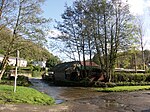Parc Cwm long cairn

Parc Cwm long cairn (Welsh: carn hir Parc Cwm), also known as Parc le Breos burial chamber (siambr gladdu Parc le Breos), is a partly restored Neolithic chambered tomb, identified in 1937 as a Severn-Cotswold type of chambered long barrow. The cromlech, a megalithic burial chamber, was built around 5850 years before present (BP), during the early Neolithic. It is about seven 1⁄2 miles (12 km) west south–west of Swansea, Wales, in what is now known as Coed y Parc Cwm at Parc le Breos, on the Gower Peninsula. A trapezoidal cairn of rubble – the upper part of the cromlech and its earth covering now removed – about 72 feet (22 m) long by 43 feet (13 m) (at its widest), is revetted by a low dry-stone wall. A bell-shaped, south-facing forecourt, formed by the wall, leads to a central passageway lined with limestone slabs set on end. Human remains had been placed in the two pairs of stone chambers that lead from the passageway. Corpses may have been placed in nearby caves until they decomposed, when the bones were moved to the tomb. The cromlech was discovered in 1869 by workmen digging for road stone. An excavation later that year revealed human bones (now known to have belonged to at least 40 people), animal remains, and Neolithic pottery. Samples from the site show the tomb to have been in use for between 300 and 800 years. North-West European lifestyles changed around 6000 BP, from the nomadic lives of the hunter-gatherer, to a settled life of agricultural farming: the Neolithic Revolution. However, analysis of the human remains found at Parc Cwm long cairn show the people interred in the cromlech continued to be either hunter-gatherers or herders, rather than agricultural farmers. Parc Cwm long cairn lies in a former medieval deer park, established in the 1220s CE by the Marcher Lord of Gower as Parc le Breos – an enclosed area of about 2,000 acres (810 ha), now mainly farmland. The cromlech is on the floor of a dry narrow limestone gorge containing about 500 acres (2.0 km2) of woodland. Free pedestrian access is via an asphalt track leading from the park's entrance, which has free parking for 12–15 cars about 250 yards (230 m) from the site. Parc Cwm long cairn is maintained by Cadw, the Welsh Government's historic environment division.
Excerpt from the Wikipedia article Parc Cwm long cairn (License: CC BY-SA 3.0, Authors, Images).Parc Cwm long cairn
South Gower Road,
Geographical coordinates (GPS) Address External links Nearby Places Show on map
Geographical coordinates (GPS)
| Latitude | Longitude |
|---|---|
| N 51.5883 ° | E -4.1126 ° |
Address
South Gower Road
SA3 2EH
Wales, United Kingdom
Open on Google Maps









